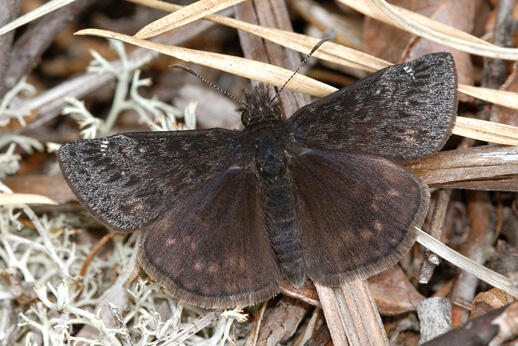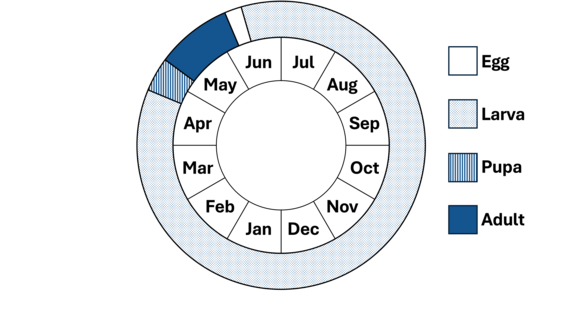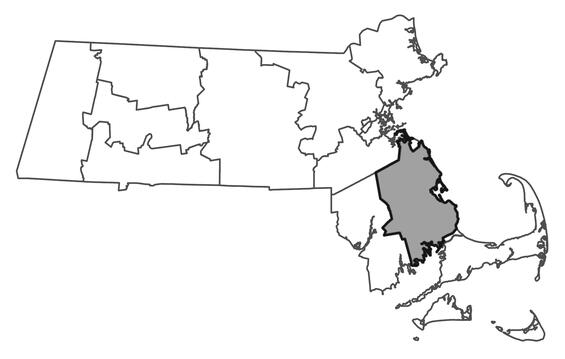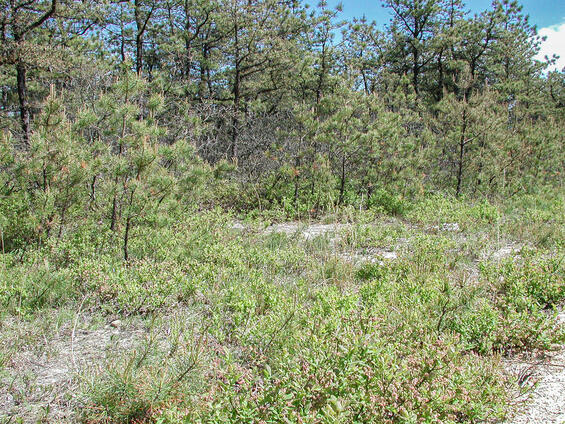- Scientific name: Erynnis persius
- Species of Greatest Conservation Need (MA State Wildlife Action Plan)
- Endangered (MA Endangered Species Act)
Description

Persius duskywing (Erynnis persius)
The Persius duskywing (Erynnis persius) is a skipper butterfly with a wingspan of 28 to 35 mm (1.1-1.4 in) (Schweitzer et al. 2011). The forewing is dark brown, almost black, while the hind wing is also dark brown but not as dark as the forewing. There are small white apical spots on the forewing and pale submarginal spots on the hind wing. The male has raised, white, hair-like scales on the forewing that render a “soft” appearance. The common wild indigo duskywing (Erynnis baptisiae) is so similar in appearance that the Persius duskywing cannot be reliably identified in the field or from a photograph. However, comparing the males of each species, the Persius duskywing typically has more raised, white, hair-like scales on the forewing than the wild indigo duskywing (but the latter also has a smaller number of similar scales); many (but not all) wild indigo duskywings have a brown patch in the distal area of the forewing that is absent on the Persius duskywing; and many (but not all) Persius duskywings have white forewing apical spots that are aligned, not offset like the wild indigo duskywing. Female Persius and wild indigo duskywings are even more similar in appearance. The only definitive way to identify the Persius duskywing is to examine the male genitalia under magnification.
Life cycle and behavior

Persius duskywing butterflies fly from early May through early June. Larvae feed on yellow wild indigo (Baptisia tinctoria) or wild lupine (Lupinus perennis) in June and July, with all individuals fully grown and entering diapause by August. Larvae overwinter and pupate in the spring.
Distribution and abundance
The Persius duskywing occupies a spotty and disjunct range in eastern North America, from southern New England west through southern Ontario and Michigan to Wisconsin, and south to New Jersey and Pennsylvania, possibly extending further south in the Appalachian Mountains (Opler 1998). During the past 60 years the Persius duskywing has declined dramatically throughout this range, including in Massachusetts, where there is currently only one known population.

Distribution in Massachusetts.
2000-2025
Based on records in the Natural Heritage Database.
Habitat
The Persius duskywing inhabits xeric, open oak woodland, sandplain pitch pine-scrub oak barrens, and other disturbance-dependent habitats with yellow wild indigo or wild lupine.
Healthy habitats are vital for supporting native wildlife and plants. Explore habitats and learn about conservation and restoration in Massachusetts.

Sandplain pitch pine-scrub oak barrens, habitat for the Persius duskywing butterfly.
Threats
The Persius duskywing is threatened by habitat loss and fire suppression in its disturbance-dependent habitats, in particular sandplain pitch pine-scrub oak barrens. Fire promotes growth of yellow wild indigo and wild lupine and maintains the open habitat structure needed by both the Persius duskywing and its host plants. Other potential threats include introduced generalist parasitoids, aerial insecticide spraying, non-target herbicide application, excessive deer browse of larval host plants, and off-road vehicles. A warming climate will likely be detrimental to the Persius duskywing, as it is a boreal species with populations south of New Jersey in cooler habitats at elevation.
Conservation
Land protection and habitat management are the primary conservation needs of this species in Massachusetts. In particular, sandplain pitch pine-scrub oak barrens should be conserved, restored, and managed to maintain habitat for this species and the entire suite of rare and threatened species dependent on such habitats.
Survey and monitoring
The distribution of the Persius duskywing in Massachusetts is well documented. The Plymouth County population of this species should be surveyed to document persistence at least once every 25 years; every 10 years is more desirable when practicable.
Management
Management of sandplain pitch pine-scrub oak barrens benefits a suite of rare and threatened species, and habitat condition should be monitored and management adapted as needed. For the Persius duskywing, open pine barrens with yellow wild indigo (Baptisia tinctoria) or wild lupine (Lupinus perennis) are of particular importance.
Research needs
The natural history and conservation needs of the Persius duskywing are relatively well known. The future effects of a warming climate on this species will likely be detrimental, and this should be monitored and documented.
References
Opler, P.A. 1998. A Field Guide to Eastern Butterflies. Peterson Field Guide Series. Houghton Mifflin, Boston, Massachusetts. 486 pp.
Schweitzer, D.F., M.C. Minno, and D.L. Wagner. 2011. Rare, Declining, and Poorly Known Butterflies and Moths (Lepidoptera) of Forests and Woodlands in the Eastern United States. Forest Service, U.S. Dept. of Agriculture, Washington, DC. 517 pp.
Contact
| Date published: | March 7, 2025 |
|---|